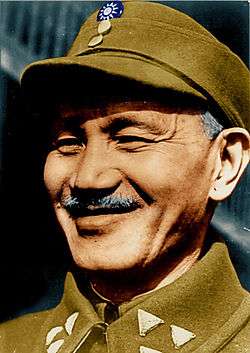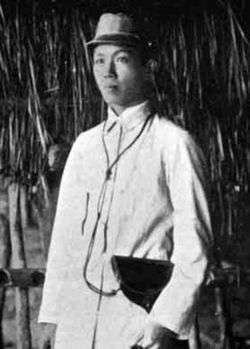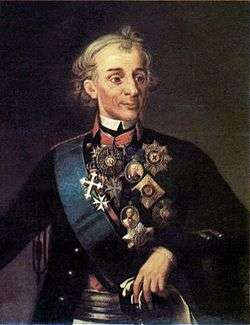Generalissimo
Generalissimo[1] (/ˌdʒɛnərəˈlɪsɪmoʊ/ JEN-(ə-)rə-LISS-im-oh) is a military rank of the highest degree, superior to field marshal and other five-star ranks in the states where they are used.
Usage
The word generalissimo (pronounced [dʒeneraˈlissimo]), an Italian term, is the absolute superlative of generale ('general') thus meaning "the highest-ranking of all generals". The superlative suffix -issimo itself derives from Latin -issimus,[2][3][4][5][6] meaning "utmost, to the highest grade". Similar cognates in other languages include generalísimo in Spanish, generalíssimo in Portuguese, généralissime in French, and generalissimus in Latin.
Historically this rank was given to a military officer leading an entire army or the entire armed forces of a state, usually only subordinate to the sovereign.[7] The military leader Albrecht von Wallenstein in 1632 was the first imperial generalissimo (general of the generals). Other usage of the rank has been for the commander of the united armies of several allied powers and if a senior military officer becomes the head of state or head of government of a nation like Chiang Kai-Shek in China and later in Taiwan, and Francisco Franco in Spain.
The rank Generalissimus of the Soviet Union would have been a generalissimo but some sources assert that Joseph Stalin refused to accept the rank.[8][9] In fact the grade was established by the Presidium of the Supreme Soviet which did not need the "approval" of Stalin.[10] The rank of Generalissimo for Stalin was used also by Western diplomacy.[11]
List of generalissimos

| Person | Service | Country | Era | Notes |
|---|---|---|---|---|
| Chiang Kai-shek | National Revolutionary Army | Republic of China | 1926 | Appointed commander in chief of the Nationalist Army for the Northern Expedition.[12] In 1935 was appointed "general special class" (特級上將 Tèjí shàng jiàng). |
| Joseph Joffre | French Army | France | 1914 | His dignity (rank) was Marshal of France, but his title as commander-in-chief of the French Army was généralissime. |
| Alexander Danilovich Menshikov | Russian Imperial Army | Russian Empire | 1727–1728 | [13] |
| Duke Anthony Ulrich of Brunswick | Russian Imperial Army | Russian Empire | 1740–1741 | [14] |
| Alexander Suvorov | Russian Imperial Army | Russian Empire | 1799 | |
| Ferdinand Foch | French Army | France | 1918 | Généralissime was the title used to describe Ferdinand Foch's Allied Command, starting 26 March 1918. He actually held the rank of général de division, the dignity (rank) of Marshal of France and later the ranks of British Field Marshal and Marshal of Poland.[15] |
| Maurice Gamelin | French Army | France | 1939 | His rank was général d'armée, but his title as commander-in-chief of the French Armed Forces was généralissime. |
| Maxime Weygand | French Army | France | 1939 | His rank was général d'armée, but his title as commander-in-chief of the French Armed Forces was généralissime. |
| Francisco de Miranda | Venezuelan Army | Venezuela | 1812 | |
| Miguel Hidalgo y Costilla | Revolutionary Army of Mexico | América Mexicana | 1810– 1811 | [16] |
| José de San Martín | Peruvian Army | Peru | 1821–1822 | Generalísimo de las Armas del Perú |
| Francisco Franco | Spanish Armed Forces | Spain | 1936–1975 | Generalísimo[17] |
| Emilio Aguinaldo | Philippine Revolutionary Army | Philippines | 1898–1901 | Generalissimo of the Katipunan[18] |
| Ihsan Nuri | Ararat Forces | Kurdish Republic of Ararat | 1927–1930 | [19] |
| Crown Prince Charles John | Royal Swedish Army | Sweden | 1810–1818 | [20][Note 1] |
| Joseph Stalin | Soviet Armed Forces | Soviet Union | 1945 | Generalissimus of the Soviet Union[21] (declined usage) |
| Kim Il-sung | Korean People's Army | North Korea | 1992 | Taewonsu[22] |
| Kim Jong-il | Korean People's Army | North Korea | 2012 | Taewonsu (posthumously awarded)[23] |
| Rafael Trujillo | Dominican Army | Dominican Republic | 1930 | [24] |
| Sun Yat-sen | National Revolutionary Army – Warlord Era (Northern Expedition) | Republic of China | 1921 | Technically as da yuan shuai or "grand marshal of the army and navy"[25][26] |
| Albrecht von Wallenstein | 30 Year's War | Holy Roman Empire via the "Principal Decree of the Imperial Deputation"[27] | 1625 | [28] |
| John J. Pershing | United States Army | United States of America | 1919 | Promoted to General of the Armies of the United States on September 3, 1919.[29] |
| John Churchill, 1st Duke of Marlborough | War of the Spanish Succession | Dutch Republic | 1702 | Referred to as Generalissimo by the Dutch States General.[30] |
| Prince George of Denmark | British Army | Kingdom of Great Britain | 1702–1708 | Declared 'Generalissimo of all our Forces within Our Kingdom of England and Ireland and Elsewhere' by his wife Queen Anne[31][32] |
| James, Duke of York | Third Anglo-Dutch War | Kingdom of England | 1673 | 'Generalissimo and Supreme Commander' over forces employed against the Dutch.[31] |
| Louis Dauphin of France | War of the Spanish Succession | France | 1708 | Commanded French Army[33] |
| Prince Consort Frederick | Swedish Army | Sweden | 1720 | [34] |
| George Washington | Continental Army United States Army | United States of America | 1776 | When chosen to be the Commander in Chief, was called by the Virginia Gazette the generalissimo of the American forces.[35] Promoted posthumously to General of the Armies of the United States on January 19, 1976 with date of rank of July 4, 1976.[36] |
| Deodoro da Fonseca | Brazilian Army | Brazil | 1890 | [37] |
| Kalākaua | Hawaiian Army | Kingdom of Hawaii | 1886–1891 | King of Hawaii, was given titles of "Supreme Commander and Generalissimo of the Hawaiian Army".[38] |
| Zhang Zuolin | National Pacification Army | Republic of China (1912–1949) | 1927–1928 | Leader of the Beiyang government, declared Generalissimo in June 1927[39] |
See also
Notes
- The Napoleonic Marshal of France Jean Baptiste Bernadotte, Prince of Ponte Corvo, was elected Crown Prince of Sweden by the Riksdag of the Estates and King Charles XIII in 1810. Given his exalted French military rank, the rank of generalissimus was likely granted him in order to give him precedence over "mere" Swedish field marshals. Once he became King of Sweden and Norway in 1818, the generalissimus rank became superfluous.
References
- Encyclopaedia Britannica: Or, A Dictionary of Arts, Sciences, and Miscellaneous Literature, Enlarged and Improved. Archibald Constable. 1823. pp. 484.
generalissimo.
- Webster's Third New International Dictionary. Missing or empty
|title=(help), French Larousse Étymologique. - "Online Etymology Dictionary". Online Etymology Dictionary.
- "Define Generalissimo at Dictionary.com". Reference.com.
- "Generalissimo – Definition and More from the Free Merriam-Webster Dictionary". Merriam-Webster.
- "Definition of generalissimo – Oxford Dictionaries (British & World English)". Oxford Dictionary of English.
- Thomas Hobbes (1660), Chapter XVIII: Of the Rights of Sovereigns by institution, retrieved 16 August 2015
- Service, Robert (2005). Stalin: A Biography. Cambridge: Harvard University Press. p. 548. ISBN 978-0-674-01697-2.
- S. M. Shtemenko. The General Staff in the War Years. Moskva 1985. Vietnamese version (vol. 2) . pp. 587–588.
- Сборник законов СССР и Указов Президиума Верховного Совета СССР (1938 — июль 1956) / Сост.: М. И. Юмашев, Б. А. Жалейко. — М., 1956. — С. 202.
- https://api.parliament.uk/historic-hansard/commons/1945/nov/07/generalissimo-stalin
- New York Times, Dec 04, 1926, pg.6.
- "Menschikow und Stalin waren die einzigen Heerführer der russischen Geschichte, die sich "Generalissimus" nennen ließen." [Menshikov and Stalin were the only military leaders in Russian history who declared themselves "generalissimus".] Jena, Detlev (1996): Die russischen Zaren in Lebensbildern, Graz, p. 520.
- https://www.hermitagemuseum.org/wps/portal/hermitage/digital-collection/01.+Paintings/128240
- John McGroarty :The Gray Man of Christ: Generalissimo Foch (1919) Los Angeles, Walter A Abbott
- Comunica Miguel Hidalgo su proclamaci n como General simo de Am rica. Documentos Historicos de Mexico, 24 Oct 1810.
- Cover, TIME magazine, 18 Oct 1943
- Whitefield, George. "Annual report of Major General George W. Davis, United States Army commanding Division of the Philippines from October 1, 1902 to July 26, 1903" (1903) [Textual record]. Archive.Org, ID: annualreportofma03unit, p. 188. Boston Public Library. OCLC 1039990497.
- Bletch Chirguh, La Question Kurde: ses origines et ses causes, Le Caire, Impimerie Paul Barbey, 1930, front cover, IHSAN NOURI PACHA Généralissime des forces nationales Kurdes (in French)
- (in Swedish) Ancienneté och Rang-Rulla öfver Krigsmagten år 1813
- Joseph Stalin was appointed Generalissimus of the Soviet Union. See: Ivan Aleksandrovich Venediktov, Selskokhozyaystvennaya yentsiklopediya, Vol. 4, Gos. izd-vo selkhoz, 1956, p. 584. (in Russian)
- The Daily Yomuiri, 29 September 2010, Kim Jong Un spotlighted / 'Heir apparent' promoted to general, makes DPRK media debut
- The Australian, 15 February 2012, Late Kim Jong-il awarded highest honour by North
- Stanley Walker, Generalissimo Rafael L. Trujillo (1955) Caribbean Library
- Linda Pomerantz-Zhang (1992). Wu Tingfang (1842–1922): Reform and Modernization in Modern Chinese History. Hong Kong University Press. p. 255. ISBN 962209287X. Retrieved 2010-10-31.
- Taylor, Jay (15 April 2009). The Generalissimo: Chiang Kai-shek and the struggle for modern China. Harvard University Press. p. 32. ISBN 978-0-674-05471-4. Retrieved 28 February 2017.
- A short history of Germany. Ernest Flagg Henderson, 1908
- Tilly und Wallenstein – ein Vergleich zweier Heerführer. Harry Horstmann, 2010. (in German)
- Public Law 66-45 of September 3, 1919 to revive the office of General of the Armies
- Rapin de Thoyras (M., Paul) (1745). Nicholas Tindal (ed.). The History of England. Volume IV, part 1 (French original: Histoire d'Angleterre, 1724–27). J. and P. Knapton. p. 562. Retrieved 16 September 2018.
The Earl of Athlone [Godard van Reede] was set on by the other Dutch Generals, to insist on his quality of Velt-Marshal, and to have the command with the Earl of Marlborough by turns. But, though he was now in high reputation by his late conduct, the States obliged him to yield this point to the Earl of Marlborough, whom they declared Generalissimo of all their forces, and sent orders to all their Generals and other Officers to obey him.
- Roper, Michael (1998). The Records of the War Office and Related Departments, 1660-1964. Kew, Surrey: Public Record Office. p. 5.
- Rapin de Thoyras (M., Paul) (1745). Nicholas Tindal (ed.). The History of England. Volume IV, part 1 (French original: Histoire d'Angleterre, 1724–27). J. and P. Knapton. p. 104. Retrieved 16 September 2018.
The Prince was Duke of Cumberland, Lord High-Admiral of Great-Britain and Ireland, Generalissimo of all her Majesty's forces both by sea and land, and Warden of the Cinque-ports.
- Rapin de Thoyras (M., Paul) (1745). Nicholas Tindal (ed.). The History of England. Volume IV, part 1 (French original: Histoire d'Angleterre, 1724–27). J. and P. Knapton. p. 68. Retrieved 16 September 2018.
But an unexpected alteration was suddenly made, and the French King declared the Duke of Burgundy Generalissimo of his forces, appointing the Duke de Vendosme [sic: Vendôme] to serve under him; and he was to be accompanied by the Duke of Berry.
- Pock, Johann Joseph (1724). Der politische, katholische Passagier, durchreisend alle hohe Höfe, Republiquen, Herrschafften und Länder der ganzen Welt. Brechenmacher. p. 832. Retrieved 16 September 2018.
wurde 1720. von dem König in Schweden [...] zum Generalissimo der sämmtlichen Schwedischen Trouppen ernennet
- Chadwick, Bruce (2005). George Washington's War: The Forging of a Revolutionary Leader and the American Presidency. Sourcebooks, Inc. p. 40. ISBN 9781402226106. Retrieved 23 November 2018.
- Public Law 94-479 of January 19, 1976 to provide for the appointment of George Washington to the grade of General of the Armies of the United States
- Andermann, Jens; Rowe, William (2006). Images of Power: Iconography, Culture and the State in Latin America. Berghahn Books. p. 176. ISBN 9781845452124.
- Chapter XXII: Act Act To Organize The Military Forces Of The Kingdom. Laws of His Majesty Kalakaua, King of the Hawaiian Islands: Passed by the Legislative Assembly at Its Session of 1886. Honolulu: Black & Auld. 1886. pp. 37–41. OCLC 42350849.
- Moore, Frederick (18 June 1927). "Chang Tso-lin Made Dictator in Move to Beat Back South". The New York Times. Retrieved 4 February 2020.



